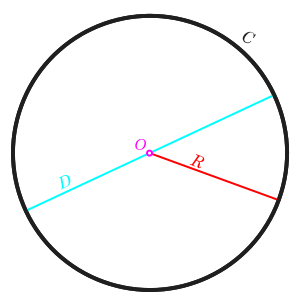Conic Sections/Circle
< Conic SectionsDefinition
The circle is the simplest and best known conic section. As a conic section, the circle is the intersection of a plane perpendicular to the cone's axis.
The geometric definition of a circle is the locus of all points a constant distance  from a point
from a point  and forming the circumference (C). The distance
and forming the circumference (C). The distance  is the radius (R) of the circle, and the point
is the radius (R) of the circle, and the point  is the circle's center also spelled as centre. The diameter (D) is twice the length of the radius.
is the circle's center also spelled as centre. The diameter (D) is twice the length of the radius.

Equations
General Form
The general equation for a circle with center  and radius
and radius  is
is
 .
.In the simplest case of a circle whose center is at the origin, the equation is simply a restatement of the Pythagorean Theorem:

General form
The general form of a circle equation is
 , where
, where <-g,-f> is the center of the circle.
Polar Coordinates
In the case of a circle centered at the origin, the polar equation of a circle is very simple because polar coordinates are essentially based on circles. For a circle with radius  ,
,
 .
.In the more complicated case of a circle with an arbitrary location, the equation is
 ,
, where
 is the distance from the circle's center to the origin and
is the distance from the circle's center to the origin and  is the angle pointing to the circle.
is the angle pointing to the circle.There are many cases that allow the equation to be simplified. If a point on the circle is touching the origin, its polar equation may consist of a single trig function.
.....
Parametric Equations
When the circle's equation is parametrized with respect to  , the equation becomes
, the equation becomes
 ,
, .
.Example
Find the center and the radius of the following circle: x2+y2+8x-10y+20=0 find by:
x2+y2+8x-10y+20=0
x2+y2+8x-10y= - 20
(x2+8x)+(y2-10y)= - 20
+16 +25 +16+25
(x2+8x+16)+(y2-10y+25)=21
(x+4)2+(y-5)2=21
Thus:
C(-4,5) radius=